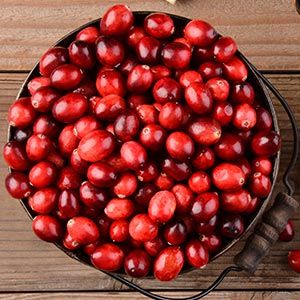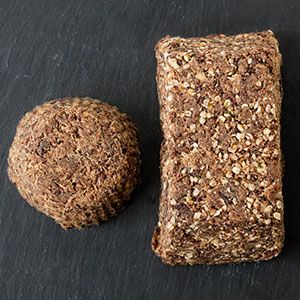Cranberries: A Healthy Thanksgiving Treat for Your Pet
These little red berries are now in season, and this holiday is the perfect time to let your pet experience the nutrition in them. Here's how to add them to your pet's meals.

STORY AT-A-GLANCE
- Cranberries are known for helping reduce the risk of urinary tract infections, thanks to a special compound called D-mannose
- These tart berries also contain other antioxidants that may support health, such as kaempferol, quercetin and ursolic acid
- Another notable antioxidant found in cranberries is quercetin, which is renowned for its anti-inflammatory properties
- Look for local, dry-grown varieties of cranberries in lieu of conventional cranberries, which have been sprayed with pesticides
Editor's Note: This article is a reprint. It was originally published March 2, 2023.
Small, red and with a tart flavor, cranberries are well-loved by Americans, but did you know that their history dates back further than the founding of the U.S.? Native Americans were the first to consume cranberries, and they called the fruits “sasemineash” and “pakimintzen.” But when the first European settlers mingled with the Native Americans, they called the fruit “crane berry” because the pink blossoms from the plant reminded them of the head of a crane.1
These tart red berries have a reputation for helping lower the risk of urinary tract disease among humans.2 But as it turns out, some studies indicate that cranberries may be beneficial for your pet as well. If you’re considering giving cranberries to your pet, this guide is for you.
Did You Know?

Cranberries are a staple of U.S. holidays, so much so that 20% of the annual harvest — which is 400 million pounds — is consumed during Thanksgiving week alone!3
The Claim to Fame of Cranberries: UTI-Busting Goodness
Before the arrival of modern medicine, cranberries were used for therapeutic applications such as stomach ailments, vomiting and appetite loss. However, one remedy cranberries are used for that has lasted through the decades is helping lower the risk of urinary tract infections (UTI).4 Research supports this finding among humans,5 but interestingly, the same benefit may apply to pets as well.
How exactly do cranberries help? According to a 2016 study conducted by Taiwanese researchers, which evaluated the effects of cranberry extract on the development of UTI in dogs, the fruit’s extract exhibits a short-term antimicrobial effect that may be helpful against the proliferation of E. coli-related UTI. Furthermore, the extract may fight multidrug-resistant bacteria in dogs with recurrent UTIs.6
While the study seems promising, don’t go looking for just any cranberry extract to give to your pet. Ideally, choose organic cranberry extract that contains D-mannose. This is a unique sugar naturally found in cranberries, as well as peaches, apples and other berries. The main benefit of D-mannose is that it is fully absorbed and quickly travels to the bladder.
Once there, it coats E. coli bacteria so they don’t adhere to the bladder walls, without increasing blood sugar or causing hyperglycemia. D-mannose can improve bladder defenses and reduce the risk of bladder infection or recurrent UTIs.
With that said, although cranberries may help bolster bladder health, if you suspect your pet has a UTI, visit your veterinarian right away. Symptoms of urinary tract infections include visible blood in the urine or litterbox, frequent urination, urine accidents, excessive licking of the genitals, pain on urination and loss of bladder control.
Bioactive Compounds Found in Cranberries
Cranberries are more than just UTI-fighting fruits. They contain various antioxidants as well, such as epicatechin, ursolic acid, caffeic acid, quercetin and kaempferol.7 These antioxidants may contribute in different ways to support your pet’s health. Epicatechin is a flavonol that may help support cognition, for instance. In one study, increasing intake of epicatechin in mice led to improved angiogenesis (the formation of new blood vessels8) and retention of spatial memory.9
Cranberries are being studied for their memory-enhancing benefits in people, which include possibly reducing the risk for dementia and cognitive decline.10 Meanwhile, ursolic acid’s potential cancer-fighting properties have been shown via in vivo animal studies.11 As for caffeic acid, one animal study demonstrated its protective effects after ischemic stroke.12
Another notable antioxidant found in cranberries is quercetin. In fact, a study noted that cranberries are one of the best sources of quercetin, ounce per ounce.13 Quercetin is renowned for its anti-inflammatory properties, as noted in published research, and may benefit conditions ranging from obesity-related inflammation to arthritis.14 Further, increased quercetin intake may help protect kidneys from diabetic nephropathy, as noted in studies using animal models.15
Cranberries Are Also Rich in Vitamins and Manganese
Aside from various antioxidants, cranberries contain other nutrients as well, such as vitamin C, vitamin K and manganese.16 A 1-tablespoon serving of chopped cranberries has 0.96 milligrams of vitamin C, which is noted for its antioxidant properties, as well as its importance for tissue growth and immune regulation.17 As for vitamin K, this fat-soluble nutrient is essential for bone metabolism and normal blood clotting,18 while manganese is needed to support healthy ligaments.19
Top Producers of Cranberries

The top two producers of cranberries in the U.S. are Wisconsin and Massachusetts. As of 2022, Wisconsin has been leading production in the country for 28 consecutive years, producing 5 million barrels of cranberries annually. Massachusetts produced less than half of that, with 2 million barrels per year.20

Sustainability of Growing Cranberries
The cultivation of cranberries, which have a growing season that lasts from April to November, is steadily becoming a problem for the environment, especially with the use of fresh water. Cranberry plants tolerate flooding, so growers flood the fields with 1.5 feet of water during harvesting to make it easier to scoop up the fruit. Further, growers typically use pesticides to fight weeds, pests and fungi common to the wetland environments where cranberries are grown, along with fertilizers that may damage the environment and consumer health.21
Ideally, look for fresh, dry-harvested cranberries, which are grown on land, not in synthetically flooded bogs. They’re typically available at natural grocers and farmers markets. If it’s not possible for you to choose dry-harvested organic or spray-free cranberries for financial or availability reasons, conventionally grown varieties may still be consumed, but make sure to wash them thoroughly first.
Cranberries Fun Fact

Some Native American recipes featuring cranberries still exist to this day, such as pemmican, a cake made with cranberries, dried meat and melted tallow that’s baked by the sun. Pemmican can last for months, which made it an important food during long travels back then.22
Selecting Cranberries for Your Pet
Frozen cranberries are available year-round, while fresh cranberries are in season during the middle of September to December. If you’re going to shop for fresh cranberries, these cold months are the best time for it. Look for ripe berries that are slightly opaque with a bright color. They should also give slightly when squeezed. Ripe cranberries make a hollow sound when you drop them back into the container or onto the counter.23 Fresh cranberries can be purchased in season and store well in the freezer for year-round feeding.
Cranberries make for good grab-and-go treats, if your pup will eat them. You can offer them in fresh, dried (no sugar added), unsweetened freeze-dried and frozen forms to your dog. But because of their tart flavor, some pets may not like cranberries at all. You can gently cook them in a small amount of water or, better yet, bone broth, to make them more palatable,24 or use them, pureed, as an ingredient in a DIY treat, mixed with other healthy fresh foods that mask their tartness. You can also puree them with fresh ground meat and spread the mixture on a lick mat.
While cranberries can be safely shared with pets, they should still be given in moderation. Keep in mind the 10% rule, wherein treats should comprise less than 10% of your pet’s daily food intake.
Beware of Cranberries in Pet Food
Due to the growing popularity of cranberries and their associated health benefits, pet food companies have started marketing foods that contain these fruits. In truth, the cranberries present in ultraprocessed pet foods won’t be enough to create a positive influence on your pet’s health because only negligible amounts of cranberries are added to the product. Their sole purpose is appealing to pet parents looking to boost their pet’s antioxidant profile or lower their risk of UTIs, both of which can be achieved through feeding real cranberries and not by offering trace amounts in dry pet foods.
Sources and References
- 1 New Jersey Government, “The Cranberry Story”
- 2 Molecules. 2020 Aug; 25(15): 3523, Introduction
- 3 AG MRC, “Cranberries”
- 4 Am Fam Physician. 2004;70(11):2175-2177, Abstract
- 5 PLOS One, September 2, 2021
- 6 American Journal of Veterinary Research. 2016 Apr;77(4):421-7
- 7 Adv Nutr. 2013 Nov; 4(6): 618–632, Table 1
- 8 National Cancer Institute, “Angiogenesis Inhibitors”
- 9 J Neurosci. 2007 May 30; 27(22): 5869–5878, Abstract
- 10 ScienceDaily, May 19, 2022
- 11 Molecules 2022, 27(21), 7466, Abstract
- 12 Behavioral and Brain Functions volume 11, Article number: 18 (2015), Abstract
- 13 The Journal of Nutrition, Volume 137, Issue 1, January 2007, Pages 186S–193S, “Quercetin’s antitumor properties”
- 14 Nutrients. 2016 Mar; 8(3): 167, 5.2.1. Animal Models
- 15 European Journal of Pharmacology Volume 921, 15 April 2022, 174868, Abstract
- 16 Cleveland Clinic, January 26, 2022
- 17 Top Companion Anim Med. 2020 Jun;39:100432
- 18 Total Health Magazine, Vitamin-K For Pets
- 19 Mount Sinai, Manganese
- 20 Farm Progress, “Cranberry harvest volume up, but below expectations”
- 21 FoodPrint, “Cranberries: Bogged Down in Water and Pollution”
- 22 Smithsonian, “Native Fruit: Cranberry for All Seasons”
- 23 Healthy Family Project, “Cranberries”
- 24 Dogs Naturally, “Can Dogs Eat Cranberries?”











